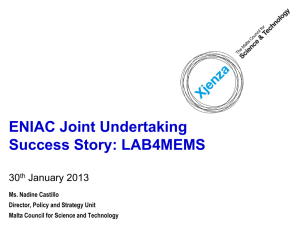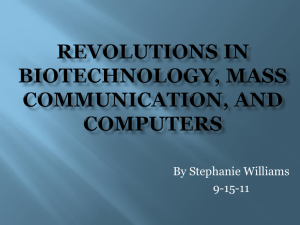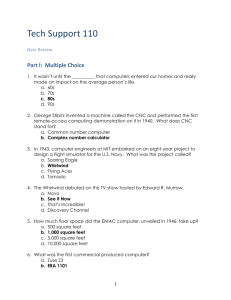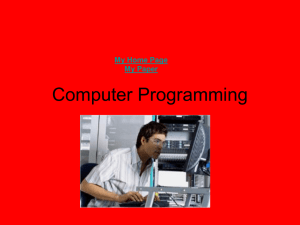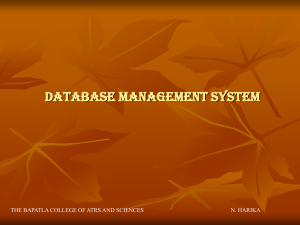Title Women`s Contribution in Technology Author Nancy Ureña Reid
advertisement
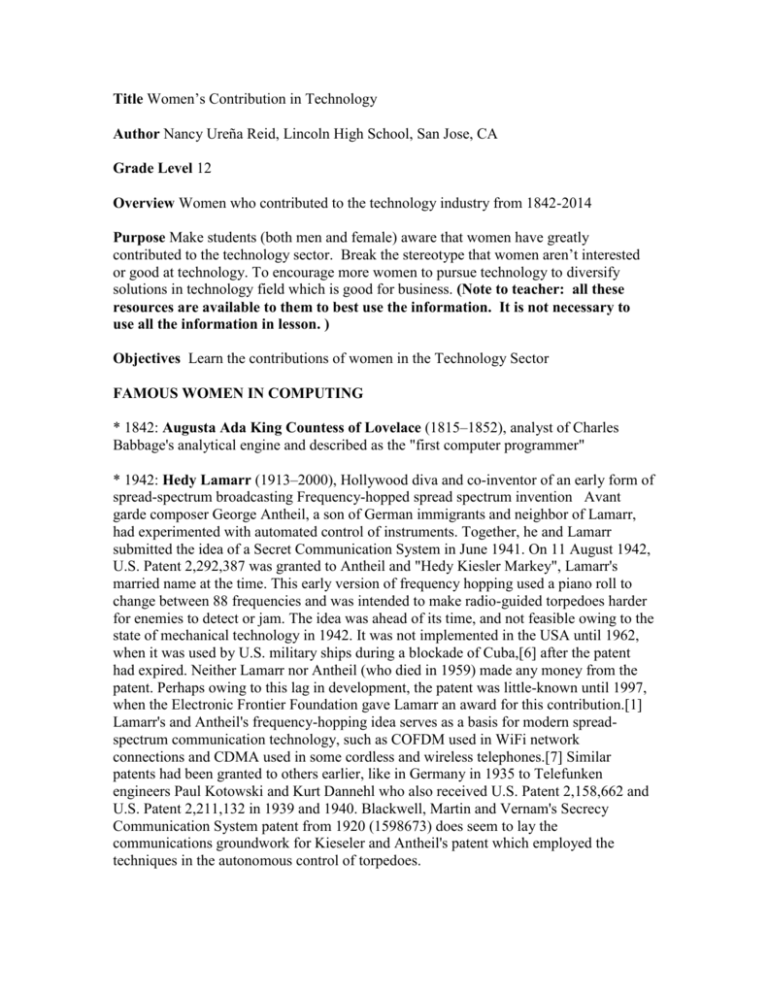
Title Women’s Contribution in Technology Author Nancy Ureña Reid, Lincoln High School, San Jose, CA Grade Level 12 Overview Women who contributed to the technology industry from 1842-2014 Purpose Make students (both men and female) aware that women have greatly contributed to the technology sector. Break the stereotype that women aren’t interested or good at technology. To encourage more women to pursue technology to diversify solutions in technology field which is good for business. (Note to teacher: all these resources are available to them to best use the information. It is not necessary to use all the information in lesson. ) Objectives Learn the contributions of women in the Technology Sector FAMOUS WOMEN IN COMPUTING * 1842: Augusta Ada King Countess of Lovelace (1815–1852), analyst of Charles Babbage's analytical engine and described as the "first computer programmer" * 1942: Hedy Lamarr (1913–2000), Hollywood diva and co-inventor of an early form of spread-spectrum broadcasting Frequency-hopped spread spectrum invention Avant garde composer George Antheil, a son of German immigrants and neighbor of Lamarr, had experimented with automated control of instruments. Together, he and Lamarr submitted the idea of a Secret Communication System in June 1941. On 11 August 1942, U.S. Patent 2,292,387 was granted to Antheil and "Hedy Kiesler Markey", Lamarr's married name at the time. This early version of frequency hopping used a piano roll to change between 88 frequencies and was intended to make radio-guided torpedoes harder for enemies to detect or jam. The idea was ahead of its time, and not feasible owing to the state of mechanical technology in 1942. It was not implemented in the USA until 1962, when it was used by U.S. military ships during a blockade of Cuba,[6] after the patent had expired. Neither Lamarr nor Antheil (who died in 1959) made any money from the patent. Perhaps owing to this lag in development, the patent was little-known until 1997, when the Electronic Frontier Foundation gave Lamarr an award for this contribution.[1] Lamarr's and Antheil's frequency-hopping idea serves as a basis for modern spreadspectrum communication technology, such as COFDM used in WiFi network connections and CDMA used in some cordless and wireless telephones.[7] Similar patents had been granted to others earlier, like in Germany in 1935 to Telefunken engineers Paul Kotowski and Kurt Dannehl who also received U.S. Patent 2,158,662 and U.S. Patent 2,211,132 in 1939 and 1940. Blackwell, Martin and Vernam's Secrecy Communication System patent from 1920 (1598673) does seem to lay the communications groundwork for Kieseler and Antheil's patent which employed the techniques in the autonomous control of torpedoes. Lamarr wanted to join the National Inventors Council, but she was told that she could better help the war effort by using her celebrity status to sell War Bonds. She once raised $7,000,000 at just one event. * 1943: WREN Colossus operators, during WW2 at Bletchley Park The Women's Royal Naval Service (WRNS; popularly and officially known as the Wrens) was the women's branch of the Royal Navy. * 1946: Betty Jennings, Betty Snyder, Fran Bilas, Kay McNulty, Marlyn Wescoff, and Ruth Lichterman, original programmers of the ENIAC The ENIAC Programmers Kathleen McNulty Mauchly Antonelli, Jean Jennings Bartik, Frances Snyder Holberton, Marlyn Wescoff Meltzer, Frances Bilas Spence and Ruth Lichterman Teitelbaum (profiles at the time of induction in 1997) The first programmers started out as "Computers." This was the name given by the Army to a group of over 80 women working at the University of Pennsylvania during World War II calculating ballistics trajectories - complex differential equations - by hand. When the Army agreed to fund an experimental project, the first all-electronic digital computer, six "Computers" were selected in 1945 to be its first programmers. They were Kathleen McNulty Mauchly Antonelli, Jean Jennings Bartik, Frances Snyder Holberton, Marlyn Wescoff Meltzer, Frances Bilas Spence and Ruth Lichterman Teitelbaum. The ENIAC was the first all-electronic digital computer, a machine of approximately 18,000 vacuum tubes and forty black 8-foot panels. Because the ENIAC project was classified, the programmers were denied access to the machine they were supposed to tame into usefulness until they received their security clearances. As the first programmers, they had no programming manuals or courses, only the logical diagrams to help them figure out how to make the ENIAC work. They had none of the programming tools of today. Instead, the programmers had to physically program the ballistics program by using the 3000 switches and dozens of cables and digit trays to physically route the data and program pulses through the machine. Therefore, the description for the first programming job might have read: "Requires physical effort, mental creativity, innovative spirit, and a high degree of patience." On February 15, 1946, the ENIAC Computer was unveiled to the public and press. It ran the ballistics trajectory programmed by the six programmers and captured the world's imagination. In 1947, the ENIAC was turned into a "stored program" computer, the world's first. Thus, these six programmers were the only generation of programmers to program it at the machine level. All six women contributed to the programming the ENIAC. Many of these pioneer programmers went on to develop innovative tools for future software engineers and to teach others early programming techniques. Marlyn Meltzer and Ruth Teitelbaum were a special team of ENIAC programmers. As "Computers" for the Army, they calculated ballistics trajectory equations painstakingly using desktop calculators, an analog technology of the time. Chosen to be ENIAC programmers, they taught themselves and others certain functions of the ENIAC and helped prepare the ballistics program. After the war, Ruth relocated with the ENIAC to Aberdeen, Maryland, where she taught the next generation of ENIAC programmers how to use the unique new computing tool. Frances Spence and Kathleen Antonelli were a second ENIAC team. Both mathematics majors in the class of 1942 of Chestnut Hill College in Philadelphia, they responded to the Army's call for mathematicians and were assigned to operate the Differential Analyzer, a huge analog machine of which there were only a few in the world. Fran and Kay led the teams of women who used this machine to calculate the ballistics equations. After the war, both Fran and Kay continued with the ENIAC to program equations for some of the world's foremost mathematicians. Kay married Dr. John Mauchly who, together with J. Presper Eckert, invented the ENIAC and UNIVAC computers, and Kay worked with John on program designs and techniques for many years. The third ENIAC programming team was comprised of Jean Bartik and Betty Holberton. As ENIAC programmers, they took on the challenging task of learning the Master Programmer that directed the performance of all program sequences of the ENIAC. They led the entire group in programming the ballistics trajectory for the February 14, 1946 demonstration, but that was only the beginning. After the War, Jean Bartik worked on the team that converted the ENIAC into a stored program machine, making it easier and faster to program larger and more sophisticated problems. Jean then programmed the BINAC, designed logic for UNIVAC I, designed an electrostatic memory backup system for UNIVAC I, and later, developed reports to help businesses understand a powerful new class of computers, the microcomputer. She worked tirelessly to make computers easier to use. After programming the ENIAC, Betty Holberton joined the company founded by Eckert and Mauchly and worked on the first commercial computers. She wrote the C-10 instruction code for UNIVAC I, forever making programming easier and faster for programmers. She designed the control console for UNIVAC I and its computer keyboards and numeric keypad. In 1952, she designed the first sort merge generator for UNIVAC I. She served on the COBOL committee to design the first business language to operate across computer platforms, wrote standards for FORTRAN and served on national and international computer standards committees for decades. Reference: Famous Women in Computing ( http://www.linuxchix.org/book/export/html/968) (viewed 3/1/2014) HIGH TECH EXECUTIVES Carly Fiorina ( Hewlett Packard CEO 1999-2005 , Lucent 1996-1999, AT &T, 19801986) viewed 3/214 http://www.biography.com/people/carly-fiorina-9542210?page=1 Meg Whitman (Hewlett Packard: 2011-present; Ebay Pres. & CEO 1998-2008) (http://investing.businessweek.com/research/stocks/people/person.asp?personId=229136 &ticker=EBAY ) Marissa Mayer (Yahoo CEO & Pres. 2012 - present; Google 1999-2012; Stanford Bachelor & Masters; Bachelors in Symbolic Systems; Masters in Science in Computer Science with specialization in artificial intelligence; 1st female engineer at Google: 20th employee) (http://www.biography.com/people/marissa-mayer-20902689) Sheryl Sandberg (COO at Facebook 2008-Present; Vice-Pres. Of Global Online Sales at Google 2001-2008; Chief of Staff for U.S. Treasure Dept under President Clinton; Consultant with McKinsey & Company; Economists with World Bank; Masters from Harvard Business School; Economics Degree at Harvard) ( www.crunchbase.com/person/sheryl-sandberg ) HIGHER EDUCATION CONTRIBUTERS Maria Klawe (Harvey Mudd College 2006-Present) A renowned mathematician, computer scientist and scholar, President Klawe is the first woman to lead the College since its 1955 founding. Prior to joining Harvey Mudd College, she served as dean of engineering and professor of computer science at Princeton University. viewed 3/2/14 (https://www.hmc.edu/about-hmc/president-klawe/) Her school has 40% women computer science majors; more than any coed higher educational institute. http://www.npr.org/blogs/alltechconsidered/2013/05/01/178810710/How-One-CollegeIs-Closing-The-Tech-Gender-Gap (check this website, see what Marie is doing to close the gap.) Ellen Spertus: Google Resercher, Mills College Professor. Working for gender equality in computer science field. ( www.mercurynews.com/mike-cassidy/ci_25201440/googleresearcher-mills-college-professor-ellen-spertus-is ) HIGH TECH INNOVATORS/ADVISORS Margarita Quihuis A Latina social entrepreneur and mentor capitalist, Margarita Quihuis’s career has focused on innovation, technology incubation, access to capital and entrepreneurship. (BS in Petroleum Engineering Degree at Stanford) (https://www.linkedin.com/in/margaritaquihuis ) ASSIGNMENT: Women in Computers Graphic Organizer NAME:________________ DUE DATE:_____ PER:____ DATE:_______ From your notes on Women’s Contribution in Technology, create a graphic organizer by choosing a theme (i.e. Five Most Important Computer Programmers; Five Most Influential Women in High Tech; Five Most Influential Women Promoting More Women Programmers). Show the names, years, and two-three word description of contribution in the United States. Use technology application to create timeline. RUBRIC: Graphic Organizer for Famous Women in Technology. 1 Handwritten, somewhat complete timeline. No Theme. At most three items. 2 Handwritten, and complete timeline. Theme stated. All five items stated. 3 Used application to create somewhat complete and organized timeline. No theme. 4 Used application to create organized and almost complete timeline. Theme stated. At most three chosen from theme. 5 Used application to create complete and organized timeline. Theme stated. All five from theme stated.
